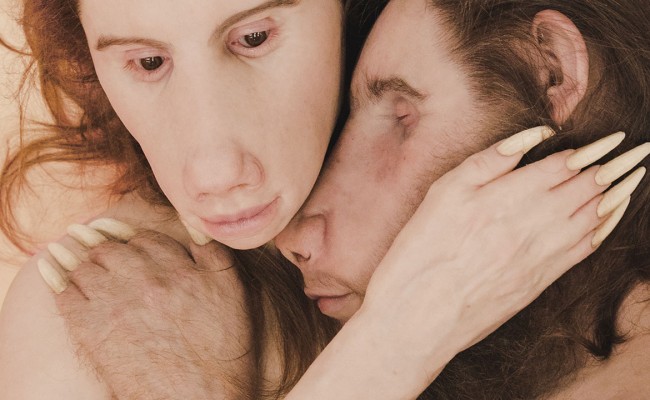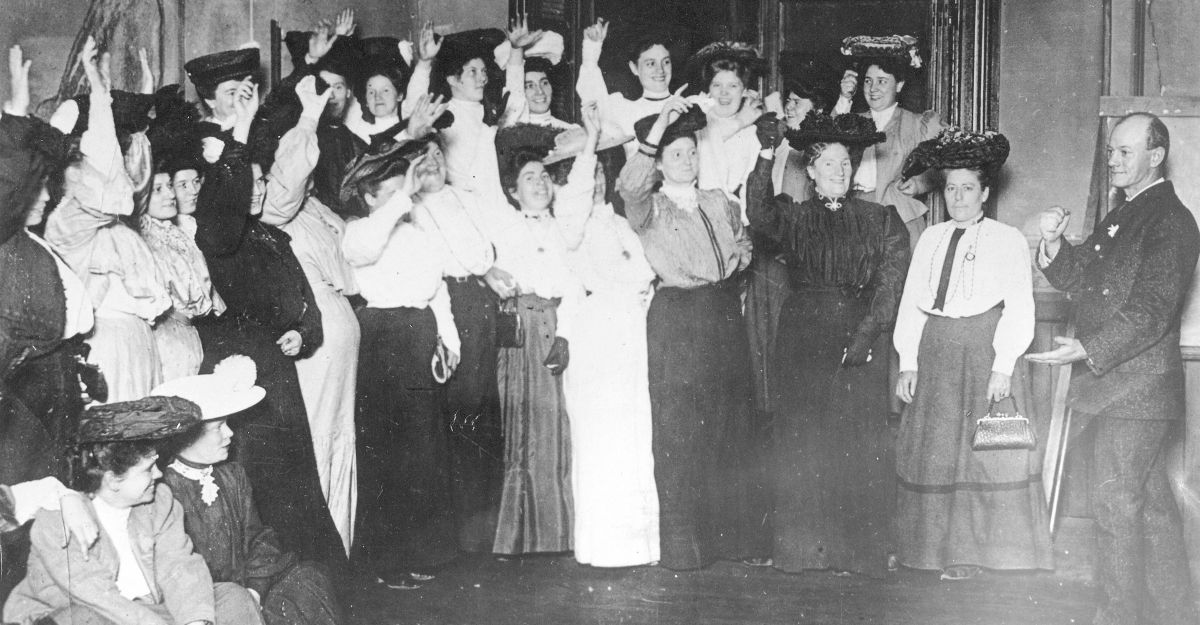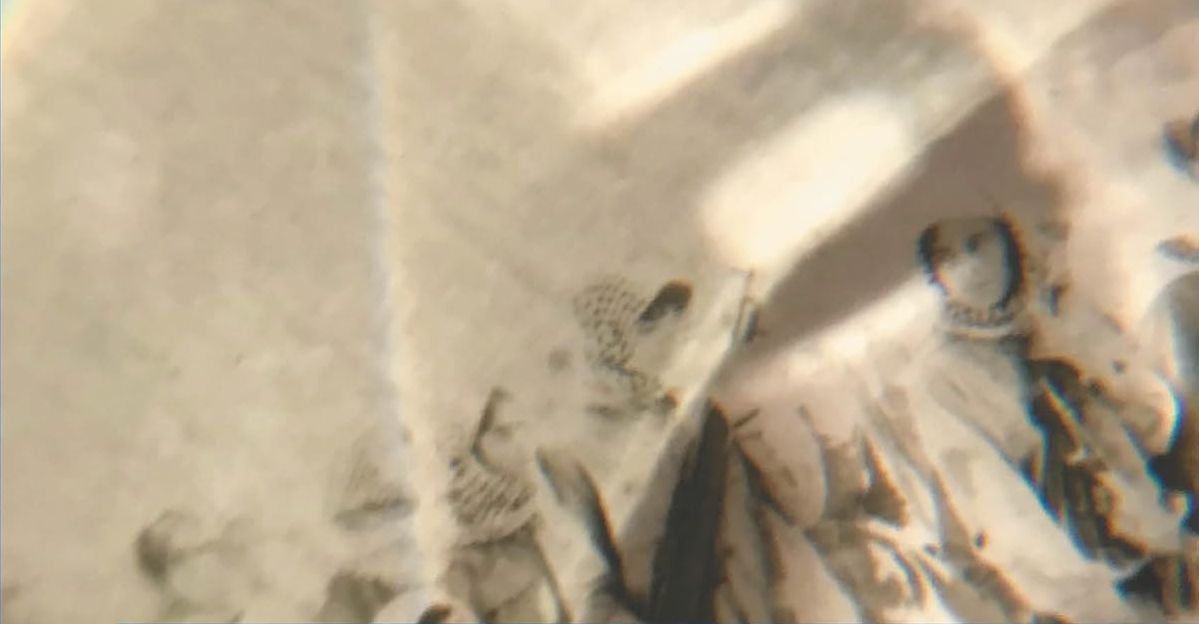The first time I saw Patricia Piccinini’s creations 10 years ago, I might have gasped. A sudden connection drew me into the eyes of The Young Family (2002), a gentle chimeric brood of human-pig-apes. I was captivated by Piccinini’s transgressive biotech fantasy because I saw how she loved them, and that these creatures, if they existed, had eyes that looked upon our world with a returned affection.
Not all of the creatures in Piccinini’s GOMA exhibition Curious Affection (24 Mar–5 Aug 2018) have eyes. Some have mouths, headlights or delicate pink anuses, but no sight. Bodily difference is explored through a disarticulation of our ‘known’ parts into the monstrous ‘other’, and these also suggest alternative sensory experiences. Piccinini subverts our stable categories of human/nonhuman, biological/mechanical, present/future. Her work exerts a push-pull of the familiar and strange, lovable and weird, and we dwell in the tension between. In this 70-something piece retrospective of Piccinini’s work we are invited into a potential world, a speculative future that returns our gaze.
As well as encountering pieces I had only seen in photographs, I also experienced new installations, including The Field (2018) of hybrid uterine-crab-flowers, waving gently in response to movement. Seeing Piccinini’s creatures up close, I was like a kid in a very weird candy store. This exhibit was personal: 10 years, one chronic illness and its after-effects later, I had become the ‘different’ body myself. Looking at the final tableaux of the exhibit, I overheard my GOMA guide in conversation with another guest. She was searching for a word.
‘What do you call them,’ she snapped her fingers, ‘Oh, Mongoloid features! Those people.’
By that point I was not surprised. My guide and I approached these artworks from very different perspectives. (It’s ‘Down syndrome’, by the way.)
Many people don’t know how to react to Piccinini’s monstrous beasties. In Susan Johnson’s Courier Mail column, spurred by fightin’ words between Des Houghton and Phil Brown regarding this exhibition, she suggested that Queenslanders didn’t ‘get’ Piccinini because of our parochial backwater legacy. This predictably caused outraged letters, with one responder claiming that the very exhibition ‘is an insult to our nation and our state’s intelligence,’ concluding: ‘I ask Susan Johnson, would she entertain having one of the more bizarre pieces from this exhibition in a prominent place in her house?’
By strangely conflating the domestic with the gallery, by missing the point, this horrified reader highlighted the questions Piccinini poses about human and nonhuman relationships. The connections between the maker and the monsters.
Where are aberrant bodies allowed to live?
Where should they be seen?
What will we allow ‘inside the house’?
Many Piccinini settings are domestic or familial: suburban Melbourne, household furniture, a caravan, a living-room rug. Scenes of comfort are disrupted by the presence of strange lifeforms demanding to be witnessed. Piccinini engages with our individual and communal hospitality:
What I would love is for people to feel an emotion that we don’t even have a name for: a feeling of warming to something that you initially found disconcerting or unpleasant or challenging … like an anti-xenophobia …
With the exception of the fanged Bodyguard (2004), the creatures of Curious Affection reach out with trust, becoming vulnerable. She challenges us to find joy and beauty in the unexpected intrusion of their ‘otherness’.
The politics of ‘ugliness’ and aversion to non-perfect bodies guide our responses to transhumanist ‘monstrosity’, but also to disability. Because those bodies and neurological states are usually deemed inadequate, partial, divergent or ‘crippled’, disability is rarely considered an integral part of the art world. Uproar over Piccinini’s work is reminiscent of public response to the rather-more-open Marc Quinn sculpture, ‘Alison Lapper Pregnant’, installed at Trafalgar Square from 2005–2007. Critics felt the statue of Lapper, an artist with phocomelia, was inappropriate and unpleasant; a too-large, too-visible disabled body for public space.
As Tobin Siebers observed, ‘Art is the active site designed to explore and expand the spectrum of humanity that we will accept among us.’ Despite attempts to exclude disability from the art world, for Siebers it is central to the experience of ‘aesthetics’: how certain bodies make other bodies ‘feel’. Because modern art is particularly concerned with physical variation and non-realistic interpretations of form, it provides a space for disability to be considered beautiful, rather than rejected as ‘broken’ or ‘ugly’.
Piccinini’s postmodern hyperrealism produces this ‘aesthetic’.
‘How we relate to difference,’ she says, ‘is a pivotal theme in my work.’ Her creations are intricate and exquisite, but are far from our commercial ideals of physical perfection. By fragmenting and composing posthuman forms, she provokes emotional engagement with ‘different’ bodies.
Piccinini doesn’t necessarily make art about disability, and I wouldn’t suggest that something like the vulva-headed Sphinx (2012) is equated with specific disabilities: rather, that ugliness, aesthetics, disability and idealised human ‘wholeness’ are intertwined.
The thematic focus on biotechnology and genetic futures means that Piccinini does sometimes engage directly with images of disability. At the start of the tour, our gallery guide introduced us to The Comforter (2010).
‘This girl’s deformity,’ she explained, ‘is called “Werewolf Syndrome.”’
Deformity.
The hairy child sits on the gallery floor, dressed in everyday children’s clothing, her back against the wall. She smiles at the not-quite-human creature held in her arms: it is rounded and chubby, with soft, plump lips and the fat digits of an infant.
‘Perhaps she smiles at it because it’s a genetic advancement,’ the guide told us, ‘something that holds her cure.’
Or perhaps the girl is not preoccupied with assimilation. Maybe she smiles at the fragile thing because she likes it.
Because they carry no visible ‘difference’, there is no suggestion that the fascination of other Piccinini child-subjects such as Doubting Thomas (2008), The Welcome Guest (2011) or Laura (with Sandwich) (2006) derives from the promise of genetic perfection or ‘cure’. Piccinini uses childlike wonder to suggest the enchantment we should find in these encounters. Expecting to fear or be repelled by monsters, we are surprised to find these bodies received with warmth or curiosity.
The Comforter also received some confusion when it sat within the University of Michigan Museum of Art. Margaret Sheridan, of the Michigan Daily, called it ‘a grotesque work’ that would lead viewers to ask ‘“why is this piece on the campus” or “why does it exist in the first place?”’ For Sheridan, the ability to accept, and feel hospitable towards, creatures is contingent on their familiarity, otherwise they are aberrant and revolting, and must stay outside.
A body like The Comforter only makes sense when it desires to be cured or hidden.
Medical advances and the pursuit of ‘perfect’ humanity are long-standing concerns of Piccinini’s career. The Young Family was a response to early discussions of hybridising humans and pigs for transplant organ harvest. We’ve moved closer to this reality, and conversations around cloning and genetic modification are practically normalised compared to a decade ago. Dolly the sheep is done and dusted, and ‘designer baby’, inspiration for works like Psychotourism (1996), is an antique term. However, bioethical dilemmas are still central to disability rights. When we breed selectively, guiding the human stock towards perfection, what bodies do we aspire to, and what ‘undesirables’ are eliminated?
Piccinini’s sculpture Prone (2011) is particularly interesting here. She disturbs the almost-sacred image of a human infant through the chimeric effect of spliced genes. The baby has the digits, nose and ears of a bat. If this child is the result of biotechnological interference, then consider its purpose. Is it possible that what we initially take as a sub-human monstrous affliction in fact creates a super-human with heightened senses? Piccinini’s work posits that, rather than ‘curing’ difference, our transgenic future might involve creating transhumans that blur lines between dis- and super-ability.
These category-breaking bodies challenge our human identity. Looking at The Young Family – the mother’s limbs suggest a human form; her pup-babies even more so. Their plump little bottoms are arrayed like an Anne Geddes portrait. One lies on its back, blue eyes dreamily gazing, its nose a rosy snub. Fingers grip its foot in a familiar infant pose. With sad maternal eyes, this image takes on almost sacred connotations: a sorrowful Madonna considering the future of her radiant child. What lives can we offer such a kindred? When are they human enough to be loved? If the baby speaks, will you still take its liver?
Mary Shelley’s Frankenstein, the horror-tale of ‘a really bad parent’, is an oft-noted influence of Piccinini’s (the 1931 film features in GOMA’s accompanying film-fest). ‘The whole of the show,’ Piccinini says, ‘is about nature and how we change nature, and our responsibility.’ To that end, this exhibition is replete with maternal imagery, exploring the responsibilities of new life propagated via genetic technology, to which we are all, in a sense, mothers.
Within the sprawling Field, we trace a path of fertility through Piccinini’s newly commissioned works; from the sweet monkey-like Pollinator (2018) to the quasi-orangutan of Kindred (2018), a sculptural mother bearing Piccinini’s own distinctive lip shape. In The Bond (2016), a human woman tenderly cradles a chimeric creature composed of human, pig and boot-tread. The same ‘child’ appears nearby in Teenage Metamorphosis (2017). He has a radio, a book, a blanket, one small arm resting above his head; a pensive coming-of-age protagonist. These ‘monsters’ of uncertain origin are nurtured and loved, not rejected.
In light of Piccinini’s concern with the responsibility owed to our creations, it was odd that my tour guide espoused the opposite view. Beside Prone stands The Carrier (2012). A naked ursine-man clasps his hands behind his back as a seat for an elderly woman. Leaning into each other, he acts as a living prosthesis, implicitly bred as the perfect ‘carrier’ for infirm humans.
Of this, our guide declared, ‘Piccinini asks what connections we will have with our mutations. She asks whether the things we make to assist us will be human enough to be able to feel affection for us.’
I mumbled, correcting, ‘or whether we will be able to feel affection for them.’ Almost in unison, the only other sub-30 on the tour said the same.
Maybe age made us see The Carrier differently. My guide’s anxiety was whether the beings charged with caring for her will be capable of love. What my fellow millennial and I saw, however, was a question of what new forms of life we would be called upon to love. This is the ‘radical empathy’, an ability to feel affection for aberrant bodies, that Piccinini asks of us.
In all this diversity of form, in these queries about what lives we will value, I noticed an omission. Pig, bat, bear or even shoe might slide into hybrid-human fleshliness, but it was all pale. If this is a view of our transhuman future, it’s hard to escape the idea that the future is white. This is troubling, not just implying that the universal symbol for ‘humanness’ is ‘whiteness’, but also because people of colour have historically been targets of eugenics and medical experimentation. That we still have white supremacist conferences about ‘scientific’ approaches to racial undesirability means that these conversations about biotech futures must take into account implications of race.
If genetic art queries who we will choose to be, and who is worth being, then where is everybody?
I could give the benefit of the doubt, say that Piccinini’s ubiquitous whiteness is a critique of a potential transhumanism where only Caucasians are considered worthy donors. But I can’t find evidence to suggest this is the case, and I think we white folk are beyond being forgiven our racial blind spots.
Piccinini’s hybrids sit on the verge of reality, one gene-splice project away from living and breathing. This post/transhumanism speculates on the future and queries the decisions we make to shape it. Beyond just asking that we ‘take responsibility’ for our scientific interference, Piccinini also suggests that these new creatures will have their own lives. The ursine-human figures of The Couple (2018), in a sleepy naked embrace beneath crisp sheets, have their own mobility and destiny, perhaps even children. What will it mean for us to exist alongside and accept difference? Heck, we aren’t even good at that now.
Piccinini doesn’t judge biotechnology as unethical but prompts us to consider how we will expand our ethical system to provide models of care and connectedness that take into account different forms of life. She asks us to respond to these ‘other’ lives with curious affection.
And I, for one, would be delighted to have them in my home.
Patricia Piccinini’s Curious Affection is showing at Queensland’s Gallery of Modern Art until 5 August.






